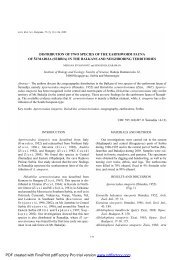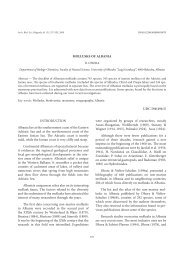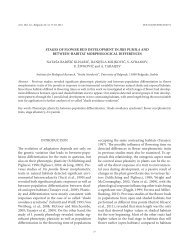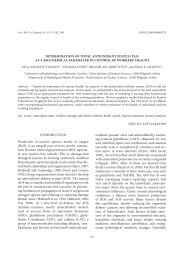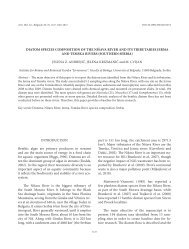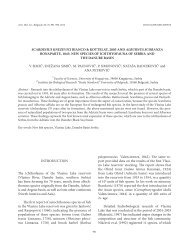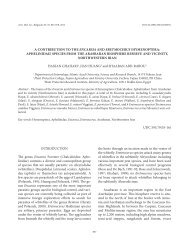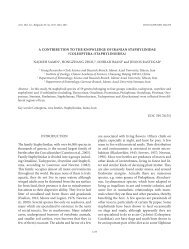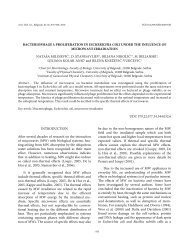Effect of ionizing (gamma) and non-ionizing (UV) radiation on the ...
Effect of ionizing (gamma) and non-ionizing (UV) radiation on the ...
Effect of ionizing (gamma) and non-ionizing (UV) radiation on the ...
You also want an ePaper? Increase the reach of your titles
YUMPU automatically turns print PDFs into web optimized ePapers that Google loves.
Arch. Biol. Sci., Belgrade, 64 (1), 287-295, 2012 DOI:10.2298/ABS1201287T<br />
EFFECT OF IONIZING (GAMMA) AND NON-IONIZING (<str<strong>on</strong>g>UV</str<strong>on</strong>g>) RADIATION ON<br />
THE DEVELOPMENT OF TRICHOGRAMMA EUPROCTIDIS<br />
(HYMENOPTERA: TRICHOGRAMMATIDAE)<br />
AYDIN S. TUNCBILEK 1 , FAHRIYE SUMER ERCAN 2 <str<strong>on</strong>g>and</str<strong>on</strong>g> ULKU CANPOLAT 1<br />
1 Department <str<strong>on</strong>g>of</str<strong>on</strong>g> Biology, Faculty <str<strong>on</strong>g>of</str<strong>on</strong>g> Sciences, Erciyes University, 39039 Kayseri, Turkey<br />
2 Department <str<strong>on</strong>g>of</str<strong>on</strong>g> Biology, , Faculty <str<strong>on</strong>g>of</str<strong>on</strong>g> Sciences <str<strong>on</strong>g>and</str<strong>on</strong>g> Literature, Bozok University, Yozgat, Turkey<br />
Abstract - The potential <str<strong>on</strong>g>of</str<strong>on</strong>g> using <str<strong>on</strong>g>gamma</str<strong>on</strong>g> <str<strong>on</strong>g>and</str<strong>on</strong>g> ultraviolet <str<strong>on</strong>g>radiati<strong>on</strong></str<strong>on</strong>g> as an alternative treatment to increase <strong>the</strong> efficiency<br />
<str<strong>on</strong>g>of</str<strong>on</strong>g> Trichogramma euproctidis (Girault 1911) (Hymenoptera: Trichogrammatidae) was investigated in <strong>the</strong> laboratory. The<br />
developmental <str<strong>on</strong>g>and</str<strong>on</strong>g> adult stages <str<strong>on</strong>g>of</str<strong>on</strong>g> T. euproctidis were exposed to <str<strong>on</strong>g>gamma</str<strong>on</strong>g> <str<strong>on</strong>g>radiati<strong>on</strong></str<strong>on</strong>g> <str<strong>on</strong>g>of</str<strong>on</strong>g> different doses (0-30 Gy) <str<strong>on</strong>g>and</str<strong>on</strong>g> ultraviolet<br />
<str<strong>on</strong>g>radiati<strong>on</strong></str<strong>on</strong>g> <str<strong>on</strong>g>of</str<strong>on</strong>g> 254 nm wavelengths (<str<strong>on</strong>g>UV</str<strong>on</strong>g>-C) for different durati<strong>on</strong>s (0-10 min) to assess <strong>the</strong>ir effect <strong>on</strong> each <str<strong>on</strong>g>of</str<strong>on</strong>g> <strong>the</strong><br />
instars <str<strong>on</strong>g>and</str<strong>on</strong>g> <strong>the</strong>ir potential in breaking <strong>the</strong> developmental cycle <str<strong>on</strong>g>of</str<strong>on</strong>g> <strong>the</strong> egg parasitoid. The LD50 values for eggs, prepupae,<br />
pupae <str<strong>on</strong>g>and</str<strong>on</strong>g> adults were 8.1, 10.0, 22.7 <str<strong>on</strong>g>and</str<strong>on</strong>g> 9.5 Gy for <str<strong>on</strong>g>gamma</str<strong>on</strong>g> <str<strong>on</strong>g>radiati<strong>on</strong></str<strong>on</strong>g> <str<strong>on</strong>g>and</str<strong>on</strong>g> 9.5, 0.12, 2.0 <str<strong>on</strong>g>and</str<strong>on</strong>g> 11.9 min for <str<strong>on</strong>g>UV</str<strong>on</strong>g> <str<strong>on</strong>g>radiati<strong>on</strong></str<strong>on</strong>g>,<br />
respectively. The pupa <str<strong>on</strong>g>and</str<strong>on</strong>g> adult stages were more radioresistant to both <str<strong>on</strong>g>gamma</str<strong>on</strong>g> <str<strong>on</strong>g>and</str<strong>on</strong>g> <str<strong>on</strong>g>UV</str<strong>on</strong>g> <str<strong>on</strong>g>radiati<strong>on</strong></str<strong>on</strong>g>. The most interesting<br />
<str<strong>on</strong>g>and</str<strong>on</strong>g> unexpected result obtained for <strong>the</strong> prepupal stage was that <str<strong>on</strong>g>UV</str<strong>on</strong>g> <str<strong>on</strong>g>radiati<strong>on</strong></str<strong>on</strong>g> has a greater effect <strong>on</strong> prepupal stages than<br />
<str<strong>on</strong>g>gamma</str<strong>on</strong>g> <str<strong>on</strong>g>radiati<strong>on</strong></str<strong>on</strong>g>.<br />
Key words: Parasitoid, Trichogramma euproctidis, l<strong>on</strong>gevity, <str<strong>on</strong>g>gamma</str<strong>on</strong>g> <str<strong>on</strong>g>radiati<strong>on</strong></str<strong>on</strong>g>, <str<strong>on</strong>g>UV</str<strong>on</strong>g> <str<strong>on</strong>g>radiati<strong>on</strong></str<strong>on</strong>g>, LD50 <str<strong>on</strong>g>and</str<strong>on</strong>g> LD99<br />
INTRODUCTION<br />
Nuclear techniques could play a vital role in enabling<br />
<strong>the</strong> cost-effective mass producti<strong>on</strong> <str<strong>on</strong>g>of</str<strong>on</strong>g> beneficial<br />
insects for use in augmentative biological c<strong>on</strong>trol.<br />
There are significant opportunities for increasing <strong>the</strong><br />
use <str<strong>on</strong>g>of</str<strong>on</strong>g> classical <str<strong>on</strong>g>and</str<strong>on</strong>g> augmentative biological c<strong>on</strong>trol<br />
through nuclear techniques for <strong>the</strong> producti<strong>on</strong> <str<strong>on</strong>g>and</str<strong>on</strong>g><br />
release <str<strong>on</strong>g>of</str<strong>on</strong>g> biological c<strong>on</strong>trol agents (Brower, 1982;<br />
Greany, 1999).<br />
The Ultraviolet (<str<strong>on</strong>g>UV</str<strong>on</strong>g>) porti<strong>on</strong> <str<strong>on</strong>g>of</str<strong>on</strong>g> <strong>the</strong> spectrum<br />
has been widely used as a germicide <str<strong>on</strong>g>and</str<strong>on</strong>g> as an attractant<br />
for insects (Bruce, 1975) in embryologicalphysiological<br />
studies for <strong>the</strong> surface disinfecti<strong>on</strong> <str<strong>on</strong>g>of</str<strong>on</strong>g><br />
insect eggs from pathogens (Bodenstein, 1953; Guerra<br />
et al., 1968) <str<strong>on</strong>g>and</str<strong>on</strong>g> for <strong>the</strong> suppressi<strong>on</strong> <str<strong>on</strong>g>of</str<strong>on</strong>g> insects <str<strong>on</strong>g>and</str<strong>on</strong>g><br />
different stages <str<strong>on</strong>g>of</str<strong>on</strong>g> <strong>the</strong> life cycle (Beard, 1972; Baden<br />
287<br />
et al., 1996). Am<strong>on</strong>g <strong>the</strong>se, <str<strong>on</strong>g>UV</str<strong>on</strong>g>-B/C <str<strong>on</strong>g>radiati<strong>on</strong></str<strong>on</strong>g> is very<br />
important in influencing biological systems (Kovacs<br />
<str<strong>on</strong>g>and</str<strong>on</strong>g> Keresztes, 2002). Egg parasitoids in <strong>the</strong> genus<br />
Trichogramma are <strong>on</strong>e <str<strong>on</strong>g>of</str<strong>on</strong>g> <strong>the</strong> most important biological<br />
c<strong>on</strong>trol agents <str<strong>on</strong>g>of</str<strong>on</strong>g> pest insects in different crops.<br />
Augmentative releases <str<strong>on</strong>g>of</str<strong>on</strong>g> <strong>the</strong> Trichogramma species<br />
require mass rearing. The eggs <str<strong>on</strong>g>of</str<strong>on</strong>g> Ephestia kuehniella<br />
Zell. (Lepidoptera: Pyralidae) are used as an<br />
alternative host for rearing Trichogramma. E. kuehniella<br />
larvae that hatch from unparasitized eggs <str<strong>on</strong>g>and</str<strong>on</strong>g><br />
can attack parasitized <strong>on</strong>es. To prevent host larvae<br />
hatch, ultra violet light (<str<strong>on</strong>g>UV</str<strong>on</strong>g>) can be used to kill host<br />
eggs. Gamma <str<strong>on</strong>g>radiati<strong>on</strong></str<strong>on</strong>g> is an <str<strong>on</strong>g>i<strong>on</strong>izing</str<strong>on</strong>g> <str<strong>on</strong>g>radiati<strong>on</strong></str<strong>on</strong>g> type<br />
<str<strong>on</strong>g>and</str<strong>on</strong>g> has a very high penetrating ability (Ayvaz <str<strong>on</strong>g>and</str<strong>on</strong>g><br />
Tunçbilek, 2006). Never<strong>the</strong>less, host eggs exposed to<br />
<str<strong>on</strong>g>gamma</str<strong>on</strong>g> ir<str<strong>on</strong>g>radiati<strong>on</strong></str<strong>on</strong>g> can be used as a food for Trichogramma<br />
rearing (Mansour, 2010). In Turkey, some<br />
studies have been c<strong>on</strong>ducted <strong>on</strong> <strong>the</strong> effect <str<strong>on</strong>g>of</str<strong>on</strong>g> <str<strong>on</strong>g>gamma</str<strong>on</strong>g>
288 AYDIN S. TUNCBILEK ET AL.<br />
rays <strong>on</strong> Trichogramma (Tuncbilek <str<strong>on</strong>g>and</str<strong>on</strong>g> Canpolat,<br />
2003; Tuncbilek <str<strong>on</strong>g>and</str<strong>on</strong>g> Ayvaz, 2001). Unfortunately, no<br />
research has been c<strong>on</strong>ducted <strong>on</strong> <strong>the</strong> effect <str<strong>on</strong>g>of</str<strong>on</strong>g> ultraviolet<br />
<str<strong>on</strong>g>radiati<strong>on</strong></str<strong>on</strong>g> <strong>on</strong> <strong>the</strong> Trichogramma. Keeping in mind<br />
<strong>the</strong> importance <str<strong>on</strong>g>and</str<strong>on</strong>g> feasibility <str<strong>on</strong>g>of</str<strong>on</strong>g> <strong>the</strong> use <str<strong>on</strong>g>of</str<strong>on</strong>g> <str<strong>on</strong>g>UV</str<strong>on</strong>g>-rays,<br />
<strong>the</strong> present investigati<strong>on</strong> was undertaken to evaluate<br />
<strong>the</strong> effect <str<strong>on</strong>g>of</str<strong>on</strong>g> <str<strong>on</strong>g>gamma</str<strong>on</strong>g> <str<strong>on</strong>g>and</str<strong>on</strong>g> <str<strong>on</strong>g>UV</str<strong>on</strong>g>-ir<str<strong>on</strong>g>radiati<strong>on</strong></str<strong>on</strong>g> <strong>on</strong> <strong>the</strong> commercially<br />
relevant aspects <str<strong>on</strong>g>of</str<strong>on</strong>g> Trichogramma rearing.<br />
It is, however, difficult to make direct comparis<strong>on</strong>s<br />
between <str<strong>on</strong>g>gamma</str<strong>on</strong>g> <str<strong>on</strong>g>and</str<strong>on</strong>g> <str<strong>on</strong>g>UV</str<strong>on</strong>g> <str<strong>on</strong>g>radiati<strong>on</strong></str<strong>on</strong>g> studies as <strong>the</strong><br />
level <str<strong>on</strong>g>of</str<strong>on</strong>g> <str<strong>on</strong>g>gamma</str<strong>on</strong>g> <str<strong>on</strong>g>and</str<strong>on</strong>g> <str<strong>on</strong>g>UV</str<strong>on</strong>g> dose achieved is not always<br />
stated, <str<strong>on</strong>g>and</str<strong>on</strong>g> <str<strong>on</strong>g>radiati<strong>on</strong></str<strong>on</strong>g> intensities vary with sources.<br />
The ability <str<strong>on</strong>g>of</str<strong>on</strong>g> <str<strong>on</strong>g>UV</str<strong>on</strong>g> to penetrate surfaces is very limited,<br />
<str<strong>on</strong>g>and</str<strong>on</strong>g> thus its effect is limited to surfaces, whereas<br />
<str<strong>on</strong>g>gamma</str<strong>on</strong>g> rays can penetrate deep into tissues. In principle,<br />
ultraviolet C (<str<strong>on</strong>g>UV</str<strong>on</strong>g>C) <str<strong>on</strong>g>radiati<strong>on</strong></str<strong>on</strong>g> may provide an<br />
effective means <str<strong>on</strong>g>of</str<strong>on</strong>g> combating pest infestati<strong>on</strong>s associated<br />
with <strong>the</strong> structure <str<strong>on</strong>g>of</str<strong>on</strong>g> a building <str<strong>on</strong>g>and</str<strong>on</strong>g> may serve<br />
as a potential new hygiene measure. Although <strong>the</strong><br />
use <str<strong>on</strong>g>of</str<strong>on</strong>g> <str<strong>on</strong>g>gamma</str<strong>on</strong>g> <str<strong>on</strong>g>radiati<strong>on</strong></str<strong>on</strong>g> as a method <str<strong>on</strong>g>of</str<strong>on</strong>g> pest c<strong>on</strong>trol<br />
has been extensively investigated (Tuncbilek, 1995;<br />
Tuncbilek <str<strong>on</strong>g>and</str<strong>on</strong>g> Kansu; 1996; Tuncbilek, 1997; Carpenter<br />
et al., 2001; Makee <str<strong>on</strong>g>and</str<strong>on</strong>g> Saour, 2003; Bloem<br />
et al., 2006), <strong>the</strong> use <str<strong>on</strong>g>of</str<strong>on</strong>g> <str<strong>on</strong>g>UV</str<strong>on</strong>g>-C <str<strong>on</strong>g>radiati<strong>on</strong></str<strong>on</strong>g> has not been<br />
widely studied due to <strong>the</strong> lack <str<strong>on</strong>g>of</str<strong>on</strong>g> penetrati<strong>on</strong> through<br />
substrates (Bruce <str<strong>on</strong>g>and</str<strong>on</strong>g> Lum, 1978).<br />
These results led us to explore <strong>the</strong> idea that <str<strong>on</strong>g>radiati<strong>on</strong></str<strong>on</strong>g><br />
is very important in enhancing parasitoid effectiveness<br />
in biological systems. The research described<br />
herein was c<strong>on</strong>ducted to examine <strong>the</strong> possible effects<br />
<str<strong>on</strong>g>of</str<strong>on</strong>g> <str<strong>on</strong>g>UV</str<strong>on</strong>g> <str<strong>on</strong>g>and</str<strong>on</strong>g> <str<strong>on</strong>g>gamma</str<strong>on</strong>g> <str<strong>on</strong>g>radiati<strong>on</strong></str<strong>on</strong>g> use in T. euproctidis.<br />
MATERIALS AND METHODS<br />
Rearing <str<strong>on</strong>g>of</str<strong>on</strong>g> Ephestia kuehniella<br />
All insects were taken from an E. kuehniella stock culture<br />
kept in <strong>the</strong> laboratory in 3 l plastic jars covered<br />
with mesh. The larvae were reared <strong>on</strong> a pesticide-free<br />
mixture c<strong>on</strong>sisting <str<strong>on</strong>g>of</str<strong>on</strong>g> 1 kg wheat flour, 5% yeast <str<strong>on</strong>g>and</str<strong>on</strong>g><br />
30 g <str<strong>on</strong>g>of</str<strong>on</strong>g> wheat germ. Throughout <strong>the</strong> rearing, cultures<br />
were kept in a rearing room equipped with a c<strong>on</strong>trolling<br />
system, at 27±1°C <str<strong>on</strong>g>and</str<strong>on</strong>g> 70±5% R.H., 16:8 h L:D.<br />
Light was c<strong>on</strong>trolled using a 24 h time switch <str<strong>on</strong>g>and</str<strong>on</strong>g><br />
fluorescent tubes.<br />
Rearing <str<strong>on</strong>g>of</str<strong>on</strong>g> Trichogramma euproctidis<br />
The wasp Trichogramma euproctidis (Girault 1911)<br />
was reared <strong>on</strong> <strong>the</strong> eggs <str<strong>on</strong>g>of</str<strong>on</strong>g> <strong>the</strong> flour moth <str<strong>on</strong>g>and</str<strong>on</strong>g> kept<br />
in test tubes at 27±1°C, 70–80% RH, 16:8 h L:D.<br />
Strips <str<strong>on</strong>g>of</str<strong>on</strong>g> lightweight cardboard (2.5 by 4 cm) were<br />
brushed with gum arabica. The eggs were sprinkled<br />
<strong>on</strong>to <strong>the</strong>se cards <str<strong>on</strong>g>and</str<strong>on</strong>g> placed in tubes al<strong>on</strong>g with adult<br />
T. euproctidis. Individual T. euproctidis females (24<br />
h old) were prepared for <strong>the</strong> tests by isolating <strong>the</strong>m<br />
in small tubes. To do this, <strong>the</strong> adults were scattered<br />
from <strong>the</strong> rearing tubes <strong>on</strong>to white paper <str<strong>on</strong>g>and</str<strong>on</strong>g> captured<br />
by placing test tubes (180 mm l<strong>on</strong>g <str<strong>on</strong>g>and</str<strong>on</strong>g> 18 mm<br />
in diameter) over <strong>the</strong>m. When <strong>the</strong> parasites walked<br />
up into <strong>the</strong> tube towards <strong>the</strong> source <str<strong>on</strong>g>of</str<strong>on</strong>g> light, <strong>the</strong>ir sex<br />
could be easily determined under a binocular microscope<br />
<str<strong>on</strong>g>and</str<strong>on</strong>g> <strong>the</strong>n <strong>the</strong> egg card was placed into <strong>the</strong> tube<br />
(Wührer <str<strong>on</strong>g>and</str<strong>on</strong>g> Hassan, 1993). After 24 h, <strong>the</strong> egg cards<br />
were removed from <strong>the</strong> tubes <str<strong>on</strong>g>and</str<strong>on</strong>g> incubated in c<strong>on</strong>trolled<br />
c<strong>on</strong>diti<strong>on</strong>s.<br />
Gamma <str<strong>on</strong>g>and</str<strong>on</strong>g> <str<strong>on</strong>g>UV</str<strong>on</strong>g> <str<strong>on</strong>g>radiati<strong>on</strong></str<strong>on</strong>g> sources<br />
T. euproctidis eggs, prepupae, pupae <str<strong>on</strong>g>and</str<strong>on</strong>g> adults were<br />
placed in glass tubes <str<strong>on</strong>g>and</str<strong>on</strong>g> irradiated in a calibrated<br />
137 Cs irradiator (IRACEL OK-GK17) with a source<br />
strength <str<strong>on</strong>g>of</str<strong>on</strong>g> ca 111 TBq <str<strong>on</strong>g>and</str<strong>on</strong>g> a dose rate <str<strong>on</strong>g>of</str<strong>on</strong>g> ca 3.20 Gy/<br />
min. Dose rate was verified with Fricke dosimetry.<br />
They were exposed to 7 dose levels ranging from 0,<br />
5, 10, 15, 20, 25 <str<strong>on</strong>g>and</str<strong>on</strong>g> 30 Gy. An unirradiated c<strong>on</strong>trol<br />
populati<strong>on</strong> (0 dose) was similarly started.<br />
All <strong>the</strong> developmental stages <str<strong>on</strong>g>of</str<strong>on</strong>g> <strong>the</strong> wasp were irradiated<br />
with <str<strong>on</strong>g>UV</str<strong>on</strong>g>-rays <str<strong>on</strong>g>of</str<strong>on</strong>g> 254 nm wavelength at different<br />
durati<strong>on</strong>: 0, 2, 4, 6, 8 <str<strong>on</strong>g>and</str<strong>on</strong>g> 10 min (Mineralight<br />
Lamp, shortwave <str<strong>on</strong>g>UV</str<strong>on</strong>g>, 254 nm 215-250 V, 56-60 Hz,<br />
0.12A). For ir<str<strong>on</strong>g>radiati<strong>on</strong></str<strong>on</strong>g>, <strong>the</strong> test insects were kept in<br />
10 cm quartz tubes placed <strong>on</strong> <strong>the</strong> surface 5 cm away<br />
from <strong>the</strong> lamp. During ir<str<strong>on</strong>g>radiati<strong>on</strong></str<strong>on</strong>g>, <strong>the</strong> room was illuminated<br />
with two 40W fluorescent bulbs <str<strong>on</strong>g>and</str<strong>on</strong>g> <strong>the</strong><br />
temperature <str<strong>on</strong>g>of</str<strong>on</strong>g> <strong>the</strong> laboratory was 27±1°C.<br />
Experiments<br />
One-day-old T. euproctidis adults were obtained<br />
from <strong>the</strong> stock culture. Male <str<strong>on</strong>g>and</str<strong>on</strong>g> female adults were
EFFECT OF IONIZING (GAMMA) AND NON-IONIZING (<str<strong>on</strong>g>UV</str<strong>on</strong>g>) RADIATION 289<br />
allowed to mate by pairing <strong>the</strong>m inside glass tubes in<br />
a growth chamber at 27±1°C, 70± 5% r.h, at a photoperiod<br />
<str<strong>on</strong>g>of</str<strong>on</strong>g> 16:8 h light:dark, respectively. Individual<br />
T. euproctidis females (24 h old) were prepared for<br />
<strong>the</strong> tests by isolating <strong>the</strong>m in small tubes for laying.<br />
Parasitized eggs were isolated into different groups,<br />
<strong>on</strong>e for <strong>the</strong> c<strong>on</strong>trol, six <str<strong>on</strong>g>and</str<strong>on</strong>g> five for <strong>the</strong> different doses<br />
<str<strong>on</strong>g>of</str<strong>on</strong>g> <str<strong>on</strong>g>gamma</str<strong>on</strong>g> <str<strong>on</strong>g>and</str<strong>on</strong>g> <str<strong>on</strong>g>UV</str<strong>on</strong>g> <str<strong>on</strong>g>radiati<strong>on</strong></str<strong>on</strong>g>, respectively. The 1-dayold<br />
parasitized eggs in each replicate were exposed to<br />
<str<strong>on</strong>g>gamma</str<strong>on</strong>g> <str<strong>on</strong>g>radiati<strong>on</strong></str<strong>on</strong>g> by placing <strong>the</strong> eggs in glass tubes,<br />
or <str<strong>on</strong>g>UV</str<strong>on</strong>g> doses by placing <strong>the</strong> eggs in quartz tubes for<br />
egg stage ir<str<strong>on</strong>g>radiati<strong>on</strong></str<strong>on</strong>g> <str<strong>on</strong>g>of</str<strong>on</strong>g> T. euproctidis. Each group<br />
c<strong>on</strong>sisted <str<strong>on</strong>g>of</str<strong>on</strong>g> five replicates, with 50 eggs/replicate.<br />
C<strong>on</strong>trol eggs were placed in <strong>the</strong> room for <strong>the</strong> designated<br />
time without being exposed to <str<strong>on</strong>g>radiati<strong>on</strong></str<strong>on</strong>g>. Eggs<br />
parasitized by T. euproctidis were treated at target<br />
<str<strong>on</strong>g>gamma</str<strong>on</strong>g> <str<strong>on</strong>g>radiati<strong>on</strong></str<strong>on</strong>g> doses <str<strong>on</strong>g>of</str<strong>on</strong>g> 0, 5, 10, 15, 20, 25 <str<strong>on</strong>g>and</str<strong>on</strong>g> 30<br />
Gy. In <strong>the</strong> <str<strong>on</strong>g>UV</str<strong>on</strong>g> <str<strong>on</strong>g>radiati<strong>on</strong></str<strong>on</strong>g> test, <strong>the</strong> eggs were treated at<br />
0, 2, 4, 6, 8 <str<strong>on</strong>g>and</str<strong>on</strong>g> 10 min exposure. After ir<str<strong>on</strong>g>radiati<strong>on</strong></str<strong>on</strong>g>,<br />
<strong>the</strong> eggs were returned to <strong>the</strong>ir corresp<strong>on</strong>ding glass<br />
tubes <str<strong>on</strong>g>and</str<strong>on</strong>g> placed into rearing room.<br />
The prepupae chosen for ir<str<strong>on</strong>g>radiati<strong>on</strong></str<strong>on</strong>g> were 4-dayold<br />
parasitized eggs. This means that <strong>the</strong> parasitized<br />
eggs were irradiated 4 days after laying. The appearance<br />
<str<strong>on</strong>g>of</str<strong>on</strong>g> black deposits <strong>on</strong> <strong>the</strong> surface was an indicati<strong>on</strong><br />
<str<strong>on</strong>g>of</str<strong>on</strong>g> <strong>the</strong> <strong>on</strong>set <str<strong>on</strong>g>of</str<strong>on</strong>g> <strong>the</strong> prepupal stage (Dahlan <str<strong>on</strong>g>and</str<strong>on</strong>g><br />
Gordh, 1997). Pupae were irradiated 8 days after laying<br />
<str<strong>on</strong>g>and</str<strong>on</strong>g> <strong>on</strong>e-day-old T. euproctidis adults were irradiated<br />
with <strong>the</strong> doses menti<strong>on</strong>ed above. After exposure<br />
to <str<strong>on</strong>g>radiati<strong>on</strong></str<strong>on</strong>g>, irradiated stages <str<strong>on</strong>g>and</str<strong>on</strong>g> c<strong>on</strong>trols were kept<br />
in <strong>the</strong> rearing rooms under <strong>the</strong> c<strong>on</strong>diti<strong>on</strong>s menti<strong>on</strong>ed<br />
above. The numbers <str<strong>on</strong>g>of</str<strong>on</strong>g> parasitized eggs, adult emergence<br />
<str<strong>on</strong>g>and</str<strong>on</strong>g> sex ratio for each stage were scored.<br />
Statistical analysis<br />
Data were subjected to analysis <str<strong>on</strong>g>of</str<strong>on</strong>g> variance (ANOVA)<br />
for <strong>the</strong> determinati<strong>on</strong> <str<strong>on</strong>g>of</str<strong>on</strong>g> differences between means,<br />
<str<strong>on</strong>g>and</str<strong>on</strong>g> when significant differences occurred, a Tukey-<br />
HSD test was applied for mean separati<strong>on</strong>. The data<br />
were transformed to square roots before statistical<br />
analysis was performed; back-transformed data are<br />
presented in <strong>the</strong> tables <str<strong>on</strong>g>and</str<strong>on</strong>g> figures. LD50 <str<strong>on</strong>g>and</str<strong>on</strong>g> LD99 values<br />
were estimated by using probit analysis with doses<br />
<str<strong>on</strong>g>of</str<strong>on</strong>g> <str<strong>on</strong>g>radiati<strong>on</strong></str<strong>on</strong>g> as sources <str<strong>on</strong>g>of</str<strong>on</strong>g> variati<strong>on</strong> (SPSS, 1999).<br />
RESULTS<br />
Egg<br />
The effects <str<strong>on</strong>g>of</str<strong>on</strong>g> applying different doses <str<strong>on</strong>g>of</str<strong>on</strong>g> <str<strong>on</strong>g>gamma</str<strong>on</strong>g><br />
<str<strong>on</strong>g>and</str<strong>on</strong>g> <str<strong>on</strong>g>UV</str<strong>on</strong>g> ir<str<strong>on</strong>g>radiati<strong>on</strong></str<strong>on</strong>g> <strong>on</strong> <strong>the</strong> subsequent development<br />
<str<strong>on</strong>g>of</str<strong>on</strong>g> eggs are shown in Fig. 1. It was found that<br />
mean parasitizati<strong>on</strong> <str<strong>on</strong>g>and</str<strong>on</strong>g> adult emergence were significantly<br />
reduced with both increased <str<strong>on</strong>g>gamma</str<strong>on</strong>g> <str<strong>on</strong>g>radiati<strong>on</strong></str<strong>on</strong>g><br />
doses but not significantly by <str<strong>on</strong>g>UV</str<strong>on</strong>g> <str<strong>on</strong>g>radiati<strong>on</strong></str<strong>on</strong>g><br />
exposure time (F=22.911, df=6, P
290 AYDIN S. TUNCBILEK ET AL.<br />
Fig. 1. Mean (±SD) parasitizati<strong>on</strong> <str<strong>on</strong>g>and</str<strong>on</strong>g> adult emergence from <str<strong>on</strong>g>gamma</str<strong>on</strong>g> <str<strong>on</strong>g>and</str<strong>on</strong>g> <str<strong>on</strong>g>UV</str<strong>on</strong>g> irradiated eggs <str<strong>on</strong>g>of</str<strong>on</strong>g> T. euproctidis.<br />
Fig. 2. Mean (±SD) adult emergence from <str<strong>on</strong>g>gamma</str<strong>on</strong>g> <str<strong>on</strong>g>and</str<strong>on</strong>g> <str<strong>on</strong>g>UV</str<strong>on</strong>g> irradiated prepupae <str<strong>on</strong>g>of</str<strong>on</strong>g> T. euproctidis.<br />
<str<strong>on</strong>g>and</str<strong>on</strong>g> <str<strong>on</strong>g>UV</str<strong>on</strong>g> irradiated T. euproctidis prepupae after 25<br />
Gy <str<strong>on</strong>g>and</str<strong>on</strong>g> 2 min, respectively, no adults developed from<br />
prepupae irradiated with higher doses or exposure<br />
times. T. euproctidis prepupae were unexpectedly<br />
more vulnerable to damage from <str<strong>on</strong>g>UV</str<strong>on</strong>g> <str<strong>on</strong>g>radiati<strong>on</strong></str<strong>on</strong>g> than<br />
from <str<strong>on</strong>g>gamma</str<strong>on</strong>g> <str<strong>on</strong>g>radiati<strong>on</strong></str<strong>on</strong>g>. To our knowledge, this is <strong>the</strong><br />
first report <str<strong>on</strong>g>of</str<strong>on</strong>g> <str<strong>on</strong>g>UV</str<strong>on</strong>g> <str<strong>on</strong>g>radiati<strong>on</strong></str<strong>on</strong>g> being more efficient than<br />
<str<strong>on</strong>g>gamma</str<strong>on</strong>g> <str<strong>on</strong>g>radiati<strong>on</strong></str<strong>on</strong>g> <strong>on</strong> <strong>the</strong> prepupal stage.<br />
Female <str<strong>on</strong>g>and</str<strong>on</strong>g> male emergences were influenced<br />
by <str<strong>on</strong>g>radiati<strong>on</strong></str<strong>on</strong>g> treatments (Female: F=52.571, df=6,<br />
P
EFFECT OF IONIZING (GAMMA) AND NON-IONIZING (<str<strong>on</strong>g>UV</str<strong>on</strong>g>) RADIATION 291<br />
Fig. 3. Mean (±SD) adult emergence from <str<strong>on</strong>g>gamma</str<strong>on</strong>g> <str<strong>on</strong>g>and</str<strong>on</strong>g> <str<strong>on</strong>g>UV</str<strong>on</strong>g> irradiated pupae <str<strong>on</strong>g>of</str<strong>on</strong>g> T. euproctidis.<br />
Fig. 4. Mean (±SD) parasitizati<strong>on</strong> <str<strong>on</strong>g>and</str<strong>on</strong>g> adult emergence from <str<strong>on</strong>g>gamma</str<strong>on</strong>g> <str<strong>on</strong>g>and</str<strong>on</strong>g> <str<strong>on</strong>g>UV</str<strong>on</strong>g> irradiated adults <str<strong>on</strong>g>of</str<strong>on</strong>g> T. euproctidis.<br />
<str<strong>on</strong>g>UV</str<strong>on</strong>g> <str<strong>on</strong>g>radiati<strong>on</strong></str<strong>on</strong>g> doses (F=11.300, df=6, P
292 AYDIN S. TUNCBILEK ET AL.<br />
Fig. 5. LD50 values <str<strong>on</strong>g>of</str<strong>on</strong>g> <str<strong>on</strong>g>gamma</str<strong>on</strong>g> <str<strong>on</strong>g>and</str<strong>on</strong>g> <str<strong>on</strong>g>UV</str<strong>on</strong>g> radiated development stages <str<strong>on</strong>g>of</str<strong>on</strong>g> T. euproctidis.<br />
Fig. 6. L<strong>on</strong>gevity <str<strong>on</strong>g>of</str<strong>on</strong>g> irradiated adult <str<strong>on</strong>g>of</str<strong>on</strong>g> T. euproctidis with <str<strong>on</strong>g>gamma</str<strong>on</strong>g> <str<strong>on</strong>g>and</str<strong>on</strong>g> <str<strong>on</strong>g>UV</str<strong>on</strong>g> <str<strong>on</strong>g>radiati<strong>on</strong></str<strong>on</strong>g>.<br />
<strong>on</strong> adults are shown in Fig. 4. The mean parasitizati<strong>on</strong><br />
(F=66.586, df=6, P
EFFECT OF IONIZING (GAMMA) AND NON-IONIZING (<str<strong>on</strong>g>UV</str<strong>on</strong>g>) RADIATION 293<br />
oresistant to <str<strong>on</strong>g>gamma</str<strong>on</strong>g> <str<strong>on</strong>g>radiati<strong>on</strong></str<strong>on</strong>g> <str<strong>on</strong>g>and</str<strong>on</strong>g> to <str<strong>on</strong>g>UV</str<strong>on</strong>g> <str<strong>on</strong>g>radiati<strong>on</strong></str<strong>on</strong>g>,<br />
respectively. The egg <str<strong>on</strong>g>and</str<strong>on</strong>g> prepupal stages were more<br />
sensitive to <str<strong>on</strong>g>gamma</str<strong>on</strong>g> <str<strong>on</strong>g>radiati<strong>on</strong></str<strong>on</strong>g> <str<strong>on</strong>g>and</str<strong>on</strong>g> to <str<strong>on</strong>g>UV</str<strong>on</strong>g> <str<strong>on</strong>g>radiati<strong>on</strong></str<strong>on</strong>g>,<br />
respectively.<br />
L<strong>on</strong>gevity<br />
The l<strong>on</strong>gevity <str<strong>on</strong>g>of</str<strong>on</strong>g> T. euproctidis adults irradiated with<br />
<str<strong>on</strong>g>gamma</str<strong>on</strong>g> <str<strong>on</strong>g>and</str<strong>on</strong>g> <str<strong>on</strong>g>UV</str<strong>on</strong>g> <str<strong>on</strong>g>radiati<strong>on</strong></str<strong>on</strong>g> are shown in Fig. 5. Although<br />
<strong>the</strong> l<strong>on</strong>gevity <str<strong>on</strong>g>of</str<strong>on</strong>g> adults irradiated with <str<strong>on</strong>g>UV</str<strong>on</strong>g><br />
<str<strong>on</strong>g>radiati<strong>on</strong></str<strong>on</strong>g> gradually decreased from 13 days to 9 days<br />
with increasing doses, it significantly decreased from<br />
11 days to 3 days with increased doses <str<strong>on</strong>g>of</str<strong>on</strong>g> <str<strong>on</strong>g>gamma</str<strong>on</strong>g> <str<strong>on</strong>g>radiati<strong>on</strong></str<strong>on</strong>g>.<br />
DISCUSSION<br />
In <strong>the</strong> present study, <str<strong>on</strong>g>gamma</str<strong>on</strong>g> <str<strong>on</strong>g>and</str<strong>on</strong>g> ultra-violet <str<strong>on</strong>g>radiati<strong>on</strong></str<strong>on</strong>g><br />
(<str<strong>on</strong>g>UV</str<strong>on</strong>g>) were used for T. euproctidis to enhance its<br />
parasitizati<strong>on</strong> <str<strong>on</strong>g>and</str<strong>on</strong>g> l<strong>on</strong>gevity. A search <str<strong>on</strong>g>of</str<strong>on</strong>g> databases for<br />
research <strong>on</strong> <str<strong>on</strong>g>gamma</str<strong>on</strong>g> <str<strong>on</strong>g>and</str<strong>on</strong>g> <str<strong>on</strong>g>UV</str<strong>on</strong>g> <str<strong>on</strong>g>radiati<strong>on</strong></str<strong>on</strong>g> <str<strong>on</strong>g>and</str<strong>on</strong>g> T. euproctidis<br />
did not yield any informati<strong>on</strong> <strong>on</strong> <strong>the</strong> minimum<br />
<str<strong>on</strong>g>radiati<strong>on</strong></str<strong>on</strong>g> doses for suppressing/stimulati<strong>on</strong>. Therefore,<br />
we chose <str<strong>on</strong>g>radiati<strong>on</strong></str<strong>on</strong>g> doses arbitrarily to evaluate<br />
<strong>the</strong> effect <str<strong>on</strong>g>of</str<strong>on</strong>g> <str<strong>on</strong>g>UV</str<strong>on</strong>g> doses <strong>on</strong> <strong>the</strong> developmental stages<br />
<str<strong>on</strong>g>of</str<strong>on</strong>g> T. euproctidis. However, <strong>the</strong> striking difference in<br />
<strong>the</strong> observed effect could be attributed in part to <strong>the</strong><br />
difference in <strong>the</strong> nature <str<strong>on</strong>g>of</str<strong>on</strong>g> <strong>the</strong> two types <str<strong>on</strong>g>of</str<strong>on</strong>g> <str<strong>on</strong>g>radiati<strong>on</strong></str<strong>on</strong>g>.<br />
The ability <str<strong>on</strong>g>of</str<strong>on</strong>g> <str<strong>on</strong>g>UV</str<strong>on</strong>g> to penetrate surfaces is very limited,<br />
<str<strong>on</strong>g>and</str<strong>on</strong>g> thus its effect is limited to surfaces, whereas<br />
<str<strong>on</strong>g>gamma</str<strong>on</strong>g> rays can penetrate deep into tissues. It is difficult<br />
to compare <strong>the</strong> effect <str<strong>on</strong>g>of</str<strong>on</strong>g> <str<strong>on</strong>g>UV</str<strong>on</strong>g> ir<str<strong>on</strong>g>radiati<strong>on</strong></str<strong>on</strong>g> with<br />
<strong>the</strong> effect <str<strong>on</strong>g>of</str<strong>on</strong>g> <str<strong>on</strong>g>gamma</str<strong>on</strong>g> ir<str<strong>on</strong>g>radiati<strong>on</strong></str<strong>on</strong>g> <strong>on</strong> T. euproctidis because<br />
<str<strong>on</strong>g>of</str<strong>on</strong>g> <strong>the</strong> difficulties involved in relating <str<strong>on</strong>g>UV</str<strong>on</strong>g> doses<br />
to <str<strong>on</strong>g>gamma</str<strong>on</strong>g> ray doses.<br />
Our study showed that <strong>the</strong> effect <str<strong>on</strong>g>of</str<strong>on</strong>g> <str<strong>on</strong>g>gamma</str<strong>on</strong>g> <str<strong>on</strong>g>radiati<strong>on</strong></str<strong>on</strong>g><br />
was more evident than <str<strong>on</strong>g>UV</str<strong>on</strong>g> <str<strong>on</strong>g>radiati<strong>on</strong></str<strong>on</strong>g> in <strong>the</strong><br />
studied doses. An increase in exposure time to <str<strong>on</strong>g>UV</str<strong>on</strong>g>rays<br />
caused a gradual decrease in <strong>the</strong> percentage <str<strong>on</strong>g>of</str<strong>on</strong>g><br />
hatching eggs. The results obtained in our study may<br />
be correlated with <strong>the</strong> findings <str<strong>on</strong>g>of</str<strong>on</strong>g> Tilt<strong>on</strong> <str<strong>on</strong>g>and</str<strong>on</strong>g> Brower<br />
(1983), who observed that <strong>the</strong> embry<strong>on</strong>ic stage <str<strong>on</strong>g>of</str<strong>on</strong>g><br />
an animal is a time <str<strong>on</strong>g>of</str<strong>on</strong>g> extreme radiosensitivity <str<strong>on</strong>g>and</str<strong>on</strong>g><br />
insects are no excepti<strong>on</strong>. It was reported that an increase<br />
in exposure time to <str<strong>on</strong>g>UV</str<strong>on</strong>g>-rays caused a gradual<br />
decrease in <strong>the</strong> percentage <str<strong>on</strong>g>of</str<strong>on</strong>g> hatching eggs <str<strong>on</strong>g>and</str<strong>on</strong>g> no<br />
hatching occurred after 24 min <str<strong>on</strong>g>of</str<strong>on</strong>g> exposure in 2- <str<strong>on</strong>g>and</str<strong>on</strong>g><br />
3-day-old eggs <str<strong>on</strong>g>of</str<strong>on</strong>g> T. c<strong>on</strong>fusum (Faruki et al., 2007).<br />
Studies have been made <strong>on</strong> unlaid eggs (Hussain et<br />
al., 1994), <strong>on</strong> embryos produced par<strong>the</strong>nogenetically<br />
(Ahmed et al., 1976) <str<strong>on</strong>g>and</str<strong>on</strong>g> <strong>on</strong> embryos produced by<br />
fertilizati<strong>on</strong> (Ghomomu, 1989).<br />
It was observed that <strong>the</strong> prepupae <str<strong>on</strong>g>of</str<strong>on</strong>g> T. euproctidis<br />
were more sensitive to <str<strong>on</strong>g>UV</str<strong>on</strong>g> rays than <strong>the</strong> eggs.<br />
The prepupae were unexpectedly most vulnerable to<br />
damage from <str<strong>on</strong>g>UV</str<strong>on</strong>g> <str<strong>on</strong>g>radiati<strong>on</strong></str<strong>on</strong>g> in comparis<strong>on</strong> to <str<strong>on</strong>g>gamma</str<strong>on</strong>g><br />
<str<strong>on</strong>g>radiati<strong>on</strong></str<strong>on</strong>g>. To our knowledge, this is <strong>the</strong> first report <str<strong>on</strong>g>of</str<strong>on</strong>g><br />
<str<strong>on</strong>g>UV</str<strong>on</strong>g> <str<strong>on</strong>g>radiati<strong>on</strong></str<strong>on</strong>g> being more efficient than <str<strong>on</strong>g>gamma</str<strong>on</strong>g> <str<strong>on</strong>g>radiati<strong>on</strong></str<strong>on</strong>g><br />
<strong>on</strong> <strong>the</strong> prepupal stage. The results obtained<br />
in our study may be correlated with <strong>the</strong> findings <str<strong>on</strong>g>of</str<strong>on</strong>g><br />
Daim<strong>on</strong>a et al. (2010) who observed that silkworm<br />
prepupae were highly sensitive to <str<strong>on</strong>g>UV</str<strong>on</strong>g>-B ir<str<strong>on</strong>g>radiati<strong>on</strong></str<strong>on</strong>g><br />
<str<strong>on</strong>g>and</str<strong>on</strong>g> <strong>the</strong>ir pupati<strong>on</strong> rates dramatically decreased with<br />
<strong>the</strong> increase <str<strong>on</strong>g>of</str<strong>on</strong>g> <str<strong>on</strong>g>radiati<strong>on</strong></str<strong>on</strong>g> dose. Early research into <strong>the</strong><br />
effects <str<strong>on</strong>g>of</str<strong>on</strong>g> ir<str<strong>on</strong>g>radiati<strong>on</strong></str<strong>on</strong>g> <strong>on</strong> larvae was made using different<br />
storage pests. Larvae are more resistant to <str<strong>on</strong>g>radiati<strong>on</strong></str<strong>on</strong>g><br />
than eggs <str<strong>on</strong>g>and</str<strong>on</strong>g> <strong>the</strong>re is a variati<strong>on</strong> in susceptibility<br />
between larval stages (Nair <str<strong>on</strong>g>and</str<strong>on</strong>g> Subramanyam,<br />
1963; Yang <str<strong>on</strong>g>and</str<strong>on</strong>g> Duc<str<strong>on</strong>g>of</str<strong>on</strong>g>f, 1971; Allotey, 1985; Johns<strong>on</strong><br />
<str<strong>on</strong>g>and</str<strong>on</strong>g> Patrick, 1988; Hasan et al., 1989).<br />
Adult eclosi<strong>on</strong> from irradiated T. euproctidis pupae<br />
gradually decreased as <str<strong>on</strong>g>gamma</str<strong>on</strong>g> <str<strong>on</strong>g>radiati<strong>on</strong></str<strong>on</strong>g> doses<br />
increased, however, adult eclosi<strong>on</strong> from <str<strong>on</strong>g>UV</str<strong>on</strong>g> irradiated<br />
pupae drastically decreased with durati<strong>on</strong> <str<strong>on</strong>g>of</str<strong>on</strong>g> exposure<br />
to <str<strong>on</strong>g>radiati<strong>on</strong></str<strong>on</strong>g>. T. euproctidis pupae were more<br />
tolerant to both <str<strong>on</strong>g>UV</str<strong>on</strong>g> <str<strong>on</strong>g>and</str<strong>on</strong>g> <str<strong>on</strong>g>gamma</str<strong>on</strong>g> <str<strong>on</strong>g>radiati<strong>on</strong></str<strong>on</strong>g>. In many<br />
ways, <strong>the</strong> pupal stage is analogous to <strong>the</strong> embry<strong>on</strong>ic<br />
stage when intense cell divisi<strong>on</strong> <str<strong>on</strong>g>and</str<strong>on</strong>g> differentiati<strong>on</strong><br />
occur. Therefore, it is not surprising that <strong>the</strong> overall<br />
pattern <str<strong>on</strong>g>of</str<strong>on</strong>g> pupal radiosensitivity is similar to <strong>the</strong> pattern<br />
exhibited by developing eggs (Tilt<strong>on</strong> <str<strong>on</strong>g>and</str<strong>on</strong>g> Brower,<br />
1983). Most studies <str<strong>on</strong>g>of</str<strong>on</strong>g> pupal radiosensitivity have<br />
not been precise enough, or at least not correlated<br />
with <strong>the</strong> morphogenetic changes occurring to reveal<br />
<strong>the</strong> fine details in <strong>the</strong> pattern <str<strong>on</strong>g>of</str<strong>on</strong>g> radiosensitivity. Ir<str<strong>on</strong>g>radiati<strong>on</strong></str<strong>on</strong>g><br />
can have several distinct effects <strong>on</strong> pupae,<br />
am<strong>on</strong>g which are pupal mortality, adult malformati<strong>on</strong>s<br />
<str<strong>on</strong>g>and</str<strong>on</strong>g> delayed adult mortality. The time sequence<br />
<str<strong>on</strong>g>of</str<strong>on</strong>g> mortality in pupae is very difficult to determine
294 AYDIN S. TUNCBILEK ET AL.<br />
<str<strong>on</strong>g>and</str<strong>on</strong>g> <strong>the</strong>ir failure to emerge is usually used to assess<br />
overall pupal mortality. Working with wheat infested<br />
by <strong>the</strong> granary beetle, Sitophilus granarius (L.),<br />
Cornwell (1966) dem<strong>on</strong>strated a marked increase in<br />
<strong>the</strong> <str<strong>on</strong>g>radiati<strong>on</strong></str<strong>on</strong>g> resistance <str<strong>on</strong>g>of</str<strong>on</strong>g> <strong>the</strong> pupae compared with<br />
larvae.<br />
Mean parasitizati<strong>on</strong> <str<strong>on</strong>g>and</str<strong>on</strong>g> adult emergence from<br />
irradiated females decreased with both increased<br />
<str<strong>on</strong>g>gamma</str<strong>on</strong>g> <str<strong>on</strong>g>and</str<strong>on</strong>g> <str<strong>on</strong>g>UV</str<strong>on</strong>g> <str<strong>on</strong>g>radiati<strong>on</strong></str<strong>on</strong>g> doses. Also, <strong>the</strong> effect <str<strong>on</strong>g>of</str<strong>on</strong>g><br />
<str<strong>on</strong>g>gamma</str<strong>on</strong>g> <str<strong>on</strong>g>radiati<strong>on</strong></str<strong>on</strong>g> <strong>on</strong> parasitizati<strong>on</strong> <str<strong>on</strong>g>and</str<strong>on</strong>g> adult emergence<br />
was more pr<strong>on</strong>ounced than <str<strong>on</strong>g>UV</str<strong>on</strong>g> <str<strong>on</strong>g>radiati<strong>on</strong></str<strong>on</strong>g>.<br />
Adult insects are more radioresistant than <strong>the</strong> o<strong>the</strong>r<br />
stages in <strong>the</strong> developmental sequence (Tilt<strong>on</strong> <str<strong>on</strong>g>and</str<strong>on</strong>g><br />
Brower, 1983). In spite <str<strong>on</strong>g>of</str<strong>on</strong>g> many studies <strong>on</strong> <strong>the</strong> effects<br />
<str<strong>on</strong>g>of</str<strong>on</strong>g> <str<strong>on</strong>g>radiati<strong>on</strong></str<strong>on</strong>g> <strong>on</strong> insects, <strong>the</strong> specific mechanisms<br />
whereby <strong>the</strong> damage is produced <str<strong>on</strong>g>and</str<strong>on</strong>g> later manifested<br />
are still not well understood. Bhuiya et al. (1991)<br />
showed a dose-dependent reducti<strong>on</strong> in adult emergence<br />
from <strong>the</strong> irradiated eggs, larvae <str<strong>on</strong>g>and</str<strong>on</strong>g> pupae <str<strong>on</strong>g>of</str<strong>on</strong>g><br />
Sitotroga cerealella <str<strong>on</strong>g>and</str<strong>on</strong>g> Oryzaephilus surinamensis.<br />
Although it is difficult to make direct comparis<strong>on</strong>s<br />
between <str<strong>on</strong>g>gamma</str<strong>on</strong>g> <str<strong>on</strong>g>and</str<strong>on</strong>g> <str<strong>on</strong>g>UV</str<strong>on</strong>g> <str<strong>on</strong>g>radiati<strong>on</strong></str<strong>on</strong>g> <strong>on</strong> <strong>the</strong>ir biological<br />
effects, fur<strong>the</strong>r research will more precisely identify<br />
<strong>the</strong> wavelengths resp<strong>on</strong>sible for prepupal death<br />
or <strong>the</strong> stimulating effect <str<strong>on</strong>g>and</str<strong>on</strong>g> relati<strong>on</strong>ships between<br />
<str<strong>on</strong>g>gamma</str<strong>on</strong>g> <str<strong>on</strong>g>and</str<strong>on</strong>g> <str<strong>on</strong>g>UV</str<strong>on</strong>g> <str<strong>on</strong>g>radiati<strong>on</strong></str<strong>on</strong>g> in events.<br />
Acknowledgment - The authors would like to thank <strong>the</strong> Research<br />
Fund <str<strong>on</strong>g>of</str<strong>on</strong>g> Erciyes University for its support through<br />
Project Number: FBT-06-84.<br />
REFERENCES<br />
Ahmed, M.Y., Elbadry, E.A., <str<strong>on</strong>g>and</str<strong>on</strong>g> Y.S. Salem (1976). <str<strong>on</strong>g>Effect</str<strong>on</strong>g>s <str<strong>on</strong>g>of</str<strong>on</strong>g><br />
<str<strong>on</strong>g>gamma</str<strong>on</strong>g> <str<strong>on</strong>g>radiati<strong>on</strong></str<strong>on</strong>g> <strong>on</strong> <strong>the</strong> reproducti<strong>on</strong> organs <str<strong>on</strong>g>of</str<strong>on</strong>g> <strong>the</strong> nor<strong>the</strong>rn<br />
cowpea weevil, Callosobruchus maculatus F. Annales<br />
de Zoologie, Ecologie Animale 8 (2), 279-284.<br />
Allotey, J. (1985). Study <str<strong>on</strong>g>of</str<strong>on</strong>g> radiosensitivity <str<strong>on</strong>g>of</str<strong>on</strong>g> <strong>the</strong> immature stages<br />
<str<strong>on</strong>g>of</str<strong>on</strong>g> Corcyra cephal<strong>on</strong>ica (Staint<strong>on</strong>) (Lepidoptera: Galleriidae).<br />
Insect Science <str<strong>on</strong>g>and</str<strong>on</strong>g> its Applicati<strong>on</strong> 6 (5), 621-625.<br />
Ayvaz, A., <str<strong>on</strong>g>and</str<strong>on</strong>g> A.S. Tunçbilek (2006). <str<strong>on</strong>g>Effect</str<strong>on</strong>g>s <str<strong>on</strong>g>of</str<strong>on</strong>g> <str<strong>on</strong>g>gamma</str<strong>on</strong>g> <str<strong>on</strong>g>radiati<strong>on</strong></str<strong>on</strong>g><br />
<strong>on</strong> life stages <str<strong>on</strong>g>of</str<strong>on</strong>g> <strong>the</strong> Mediterranean flour moth, Ephestia<br />
kuehniella Zeller (Lepidoptera: Pyralidae). Journal <str<strong>on</strong>g>of</str<strong>on</strong>g> Pest<br />
Science, 79, 215-222.<br />
Baden, H.P., Kollias, N., Anders<strong>on</strong>, R.R., Hopkins, T, <str<strong>on</strong>g>and</str<strong>on</strong>g> L. Raffery<br />
(1996). Drosophila melanogaster larvae detect low<br />
doses <str<strong>on</strong>g>of</str<strong>on</strong>g> <str<strong>on</strong>g>UV</str<strong>on</strong>g>C <str<strong>on</strong>g>radiati<strong>on</strong></str<strong>on</strong>g> as manifested by a writhing resp<strong>on</strong>se.<br />
Archives <str<strong>on</strong>g>of</str<strong>on</strong>g> Insect Biochemistry <str<strong>on</strong>g>and</str<strong>on</strong>g> Physiology 32,<br />
187-196.<br />
Beard, R.L. (1972). Lethal acti<strong>on</strong> <str<strong>on</strong>g>of</str<strong>on</strong>g> <str<strong>on</strong>g>UV</str<strong>on</strong>g> ir<str<strong>on</strong>g>radiati<strong>on</strong></str<strong>on</strong>g> <strong>on</strong> insects.<br />
Journal <str<strong>on</strong>g>of</str<strong>on</strong>g> Ec<strong>on</strong>omic Entomology 65, 650-654.<br />
Bhuiya, A.D., Ahmed, M., Rezaur, R., Nahar, G., Huda, S.M.S.,<br />
<str<strong>on</strong>g>and</str<strong>on</strong>g> S.A.K.M., Hossain (1991). Radiati<strong>on</strong> disinfestati<strong>on</strong> <str<strong>on</strong>g>of</str<strong>on</strong>g><br />
pulses, oilseeds <str<strong>on</strong>g>and</str<strong>on</strong>g> tobacco leaves. In insect disinfestati<strong>on</strong><br />
<str<strong>on</strong>g>of</str<strong>on</strong>g> food <str<strong>on</strong>g>and</str<strong>on</strong>g> agricultural products by ir<str<strong>on</strong>g>radiati<strong>on</strong></str<strong>on</strong>g>. Proceeding<br />
<str<strong>on</strong>g>of</str<strong>on</strong>g> final research co-ordinati<strong>on</strong> meeting, Vienna: IAEA.<br />
pp. 27-50.<br />
Bloem, S., Carpenter, J.E., <str<strong>on</strong>g>and</str<strong>on</strong>g> S. Dorn (2006). Mobility <str<strong>on</strong>g>of</str<strong>on</strong>g> mass<br />
reared diapaused <str<strong>on</strong>g>and</str<strong>on</strong>g> <str<strong>on</strong>g>n<strong>on</strong></str<strong>on</strong>g>diapaused Cydia pom<strong>on</strong>ella<br />
(Lepidoptera: Tortricidae): effect <str<strong>on</strong>g>of</str<strong>on</strong>g> mating status <str<strong>on</strong>g>and</str<strong>on</strong>g><br />
treatment with <str<strong>on</strong>g>gamma</str<strong>on</strong>g> <str<strong>on</strong>g>radiati<strong>on</strong></str<strong>on</strong>g>. Journal <str<strong>on</strong>g>of</str<strong>on</strong>g> Ec<strong>on</strong>omic Entomology<br />
99, 699-706.<br />
Bodenstein, D. (1953). Embry<strong>on</strong>ic development. In: Roder KD,<br />
editor. Insect Physiology pp. 780-822. John Wiley <str<strong>on</strong>g>and</str<strong>on</strong>g> S<strong>on</strong>s<br />
Publishing.<br />
Brower, J.H. (1982). Parasitizati<strong>on</strong> <str<strong>on</strong>g>of</str<strong>on</strong>g> irradiated eggs from irradiated<br />
adults <str<strong>on</strong>g>of</str<strong>on</strong>g> <strong>the</strong> Indian Meal Moth (Lepidoptera:<br />
Pyralidae) by Trichogramma pretiosum (Hymenoptera:<br />
Trichogrammatidae). Journal <str<strong>on</strong>g>of</str<strong>on</strong>g> Ec<strong>on</strong>omic Entomology 75,<br />
939-944.<br />
Bruce, W.A. (1975). <str<strong>on</strong>g>Effect</str<strong>on</strong>g> <str<strong>on</strong>g>of</str<strong>on</strong>g> <str<strong>on</strong>g>UV</str<strong>on</strong>g>-<str<strong>on</strong>g>radiati<strong>on</strong></str<strong>on</strong>g> <strong>on</strong> egg hatch <str<strong>on</strong>g>of</str<strong>on</strong>g> Plodia<br />
interpunctella (Lepidoptera: Pyralidae). Journal <str<strong>on</strong>g>of</str<strong>on</strong>g> Stored<br />
Product Research 11, 243-244.<br />
Bruce, W.A., <str<strong>on</strong>g>and</str<strong>on</strong>g> P.T.M., Lum (1978). The effects <str<strong>on</strong>g>of</str<strong>on</strong>g> <str<strong>on</strong>g>UV</str<strong>on</strong>g> <str<strong>on</strong>g>radiati<strong>on</strong></str<strong>on</strong>g><br />
<strong>on</strong> stored-product insects. In: Caswell GH, Bosh<str<strong>on</strong>g>of</str<strong>on</strong>g>f WH,<br />
Daramola AM, Dina SO, Adesuyi SA, Singh SR, Ivbijaro<br />
MF, Adeyemi SAO, Taylor TA, editors. Proceedings <str<strong>on</strong>g>of</str<strong>on</strong>g> <strong>the</strong><br />
Sec<strong>on</strong>d Internati<strong>on</strong>al Working C<strong>on</strong>ference <strong>on</strong> Stored-Product<br />
Entomology, pp. 271-277. Ibadan, Nigeria.<br />
Carpenter, J.E., Bloem, K.A., <str<strong>on</strong>g>and</str<strong>on</strong>g> S, Bloem (2001). Applicati<strong>on</strong>s<br />
<str<strong>on</strong>g>of</str<strong>on</strong>g> F1 sterility for research <str<strong>on</strong>g>and</str<strong>on</strong>g> management <str<strong>on</strong>g>of</str<strong>on</strong>g> Cactoblastis<br />
cactorum (Lepidoptera: Pyralidae). Florida Entomology<br />
84, 531-536.<br />
Cornwell, P.B. (1966). The entomology <str<strong>on</strong>g>of</str<strong>on</strong>g> <str<strong>on</strong>g>radiati<strong>on</strong></str<strong>on</strong>g> disinfestati<strong>on</strong><br />
<str<strong>on</strong>g>of</str<strong>on</strong>g> grain, Pergam<strong>on</strong> Press, L<strong>on</strong>d<strong>on</strong>. pp. 236.<br />
Daim<strong>on</strong>, T, Hirayama, S, Kanai, M, Ruike, Y, Meng, Y, Kosegawa,<br />
E, Nakamura, M, Tsujimoto, G., Katsuma, S., <str<strong>on</strong>g>and</str<strong>on</strong>g> T. Shimada<br />
(2010). The silkworm Green b locus encodes a quercetin<br />
5-O-glucosyltransferase that produces green coco<strong>on</strong>s<br />
with <str<strong>on</strong>g>UV</str<strong>on</strong>g>-shielding properties. Proceedings <str<strong>on</strong>g>of</str<strong>on</strong>g> <strong>the</strong> Nati<strong>on</strong>al<br />
Academy <str<strong>on</strong>g>of</str<strong>on</strong>g> Sciences (PNAS) 107 (25), 11471-11476.<br />
Dahlan, A.N., <str<strong>on</strong>g>and</str<strong>on</strong>g> G. Gordh (1997). Development <str<strong>on</strong>g>of</str<strong>on</strong>g> Trichogramma<br />
australicum (Hymenoptera: Trichogrammatidae)<br />
at low <str<strong>on</strong>g>and</str<strong>on</strong>g> high populati<strong>on</strong> density in artificial diet. Entomophaga<br />
42, 525-536.
EFFECT OF IONIZING (GAMMA) AND NON-IONIZING (<str<strong>on</strong>g>UV</str<strong>on</strong>g>) RADIATION 295<br />
Faruki, S.I., Das, D.R., Khan, A.R., <str<strong>on</strong>g>and</str<strong>on</strong>g> M. Khatun (2007). <str<strong>on</strong>g>Effect</str<strong>on</strong>g>s<br />
<str<strong>on</strong>g>of</str<strong>on</strong>g> ultraviolet (254nm) ir<str<strong>on</strong>g>radiati<strong>on</strong></str<strong>on</strong>g> <strong>on</strong> egg hatching <str<strong>on</strong>g>and</str<strong>on</strong>g><br />
adult emergence <str<strong>on</strong>g>of</str<strong>on</strong>g> <strong>the</strong> flour beetles, Tribolium castaneum,<br />
T. c<strong>on</strong>fusum <str<strong>on</strong>g>and</str<strong>on</strong>g> <strong>the</strong> alm<strong>on</strong>d moth, Cadra cautella. Journal<br />
<str<strong>on</strong>g>of</str<strong>on</strong>g> Insect Science 7 (36), 1-6.<br />
Ghomomu, T.R. (1989). Some observati<strong>on</strong>s <strong>on</strong> <strong>the</strong> reproducti<strong>on</strong><br />
<str<strong>on</strong>g>of</str<strong>on</strong>g> adults <str<strong>on</strong>g>of</str<strong>on</strong>g> <strong>the</strong> cowpea weevil, Callosobruchus maculatus<br />
F. resulting from <strong>the</strong> irradiated stages. Parasitica 45 (4),<br />
99-104.<br />
Greany, P. (1999). The potential role <str<strong>on</strong>g>of</str<strong>on</strong>g> nuclear techniques in<br />
support <str<strong>on</strong>g>of</str<strong>on</strong>g> <strong>the</strong> producti<strong>on</strong> <str<strong>on</strong>g>of</str<strong>on</strong>g> biological c<strong>on</strong>trol agents <str<strong>on</strong>g>of</str<strong>on</strong>g><br />
insect pests, In: Use <str<strong>on</strong>g>of</str<strong>on</strong>g> nuclear techniques in biological c<strong>on</strong>trol:<br />
Managing pests, facilitating trade <str<strong>on</strong>g>and</str<strong>on</strong>g> protecting envir<strong>on</strong>ment.<br />
Report <str<strong>on</strong>g>of</str<strong>on</strong>g> a c<strong>on</strong>sultants’ group meeting, Vienna,<br />
IAEA-314-D4-97CT02288.<br />
Guerra, A.A., Ouye, M.T., <str<strong>on</strong>g>and</str<strong>on</strong>g> H.R. Bullock (1968). <str<strong>on</strong>g>Effect</str<strong>on</strong>g> <str<strong>on</strong>g>of</str<strong>on</strong>g> ultraviolet<br />
ir<str<strong>on</strong>g>radiati<strong>on</strong></str<strong>on</strong>g> <strong>on</strong> egg hatch, subsequent larval development,<br />
<str<strong>on</strong>g>and</str<strong>on</strong>g> adult l<strong>on</strong>gevity <str<strong>on</strong>g>of</str<strong>on</strong>g> <strong>the</strong> tobacco budworm<br />
<str<strong>on</strong>g>and</str<strong>on</strong>g> <strong>the</strong> bollworm. Journal <str<strong>on</strong>g>of</str<strong>on</strong>g> Ec<strong>on</strong>omical Entomology 61,<br />
541-542.<br />
Hasan, M., Khalequzzaman, M, <str<strong>on</strong>g>and</str<strong>on</strong>g> A.R. Khan (1989). Development<br />
<str<strong>on</strong>g>of</str<strong>on</strong>g> Tribolium anaphe irradiated as larvae <str<strong>on</strong>g>of</str<strong>on</strong>g> various<br />
ages with <str<strong>on</strong>g>gamma</str<strong>on</strong>g> rays. Entomologia Experimentalis et Applicata<br />
53, 92-94.<br />
Hussain, T., Imura, O., <str<strong>on</strong>g>and</str<strong>on</strong>g> Z.A.Qureshi (1994). <str<strong>on</strong>g>Effect</str<strong>on</strong>g> <str<strong>on</strong>g>of</str<strong>on</strong>g> <str<strong>on</strong>g>gamma</str<strong>on</strong>g><br />
<str<strong>on</strong>g>radiati<strong>on</strong></str<strong>on</strong>g> <strong>on</strong> post-embry<strong>on</strong>ic development following ir<str<strong>on</strong>g>radiati<strong>on</strong></str<strong>on</strong>g><br />
<str<strong>on</strong>g>of</str<strong>on</strong>g> Callosobruchus chinensis eggs. Pakistan Journal<br />
<str<strong>on</strong>g>of</str<strong>on</strong>g> Zoology 26 (1), 7-9.<br />
Johns<strong>on</strong>, J.A., <str<strong>on</strong>g>and</str<strong>on</strong>g> V.V. Patrick (1988). Post-treatment, survival,<br />
development, <str<strong>on</strong>g>and</str<strong>on</strong>g> feeding <str<strong>on</strong>g>of</str<strong>on</strong>g> irradiated Indian meal moth<br />
<str<strong>on</strong>g>and</str<strong>on</strong>g> Navel orange worm larvae (Lepidoptera: Pyralidae).<br />
Journal <str<strong>on</strong>g>of</str<strong>on</strong>g> Ec<strong>on</strong>omical Entomology 81 (1), 376-380.<br />
Kovacs, E., <str<strong>on</strong>g>and</str<strong>on</strong>g> A. Keresztes (2002). <str<strong>on</strong>g>Effect</str<strong>on</strong>g> <str<strong>on</strong>g>of</str<strong>on</strong>g> <str<strong>on</strong>g>gamma</str<strong>on</strong>g> <str<strong>on</strong>g>and</str<strong>on</strong>g> <str<strong>on</strong>g>UV</str<strong>on</strong>g>-B/C<br />
<str<strong>on</strong>g>radiati<strong>on</strong></str<strong>on</strong>g> <strong>on</strong> plant cells. Micr<strong>on</strong> 33, 199-210.<br />
Makee, H., <str<strong>on</strong>g>and</str<strong>on</strong>g> G. Saour (2003). N<strong>on</strong>inherited sterility in irradiated<br />
Phthorimaea operculella females. Journal <str<strong>on</strong>g>of</str<strong>on</strong>g> Applied<br />
Entomology 127, 489-493.<br />
Mansour, M. (2010). <str<strong>on</strong>g>Effect</str<strong>on</strong>g>s <str<strong>on</strong>g>of</str<strong>on</strong>g> <str<strong>on</strong>g>gamma</str<strong>on</strong>g> <str<strong>on</strong>g>radiati<strong>on</strong></str<strong>on</strong>g> <strong>on</strong> <strong>the</strong> Mediterranean<br />
flour moth, Ephestia kuehniella, eggs <str<strong>on</strong>g>and</str<strong>on</strong>g> acceptability<br />
<str<strong>on</strong>g>of</str<strong>on</strong>g> irradiated eggs by Trichogramma cacoeciae<br />
females. J. Pest. Sci. 83,243–249.<br />
Nair, K.K., <str<strong>on</strong>g>and</str<strong>on</strong>g> G. Subramanyam (1963). <str<strong>on</strong>g>Effect</str<strong>on</strong>g>s <str<strong>on</strong>g>of</str<strong>on</strong>g> variable doserate<br />
<strong>on</strong> <str<strong>on</strong>g>radiati<strong>on</strong></str<strong>on</strong>g> damage in <strong>the</strong> rust-red flour beetle, Tribolium<br />
castaneum Herbst, In: Radiati<strong>on</strong> <str<strong>on</strong>g>and</str<strong>on</strong>g> radioisotopes<br />
applied to insects <str<strong>on</strong>g>of</str<strong>on</strong>g> agricultural importance, pp. 425-429.<br />
STI/PUB/74, IAEA, Vienna.<br />
SPSS. (1999). SPSS Versi<strong>on</strong> 10.0. SPSS Inc, 233 S. Wacker Drive,<br />
Chicago, Illinois.<br />
Tilt<strong>on</strong>, E.W., <str<strong>on</strong>g>and</str<strong>on</strong>g> J.H. Brower (1983). Radiati<strong>on</strong> effects <strong>on</strong> arthropods.<br />
In: Josephs<strong>on</strong> ES, Peters<strong>on</strong> MS, editors. Preservati<strong>on</strong><br />
<str<strong>on</strong>g>of</str<strong>on</strong>g> food by <str<strong>on</strong>g>i<strong>on</strong>izing</str<strong>on</strong>g> <str<strong>on</strong>g>radiati<strong>on</strong></str<strong>on</strong>g>, Vol. 2, pp. 269-316. Boca Rat<strong>on</strong>,<br />
FL: CRC Press Inc.<br />
Tuncbilek, A.S., <str<strong>on</strong>g>and</str<strong>on</strong>g> U. Canpolat (2003). <str<strong>on</strong>g>Effect</str<strong>on</strong>g>s <str<strong>on</strong>g>of</str<strong>on</strong>g> Stored <str<strong>on</strong>g>and</str<strong>on</strong>g><br />
Gamma Irradiated Host-Eggs <strong>on</strong> Some Performance<br />
Characteristics <str<strong>on</strong>g>of</str<strong>on</strong>g> Trichogramma evanescens. European<br />
Society <str<strong>on</strong>g>of</str<strong>on</strong>g> New Methods in Agricultural Research, XXXIII th<br />
Annual Meeting, Viterbo, Italy p. 96<br />
Tuncbilek, A.S., <str<strong>on</strong>g>and</str<strong>on</strong>g> A. Ayvaz (2001). The use <str<strong>on</strong>g>of</str<strong>on</strong>g> nuclear techniques<br />
for <strong>the</strong> producti<strong>on</strong> <str<strong>on</strong>g>and</str<strong>on</strong>g> col<strong>on</strong>izati<strong>on</strong> <str<strong>on</strong>g>of</str<strong>on</strong>g> Trichogramma<br />
evanescens to manage flour moth, Ephestia kuehniella,<br />
In: Evaluating <strong>the</strong> use <str<strong>on</strong>g>of</str<strong>on</strong>g> nuclear techniques for <strong>the</strong> col<strong>on</strong>izati<strong>on</strong><br />
<str<strong>on</strong>g>and</str<strong>on</strong>g> producti<strong>on</strong> <str<strong>on</strong>g>of</str<strong>on</strong>g> natural enemies <str<strong>on</strong>g>of</str<strong>on</strong>g> agricultural insect<br />
pests, Sec<strong>on</strong>d Research Co-ordinati<strong>on</strong> Meeting Organized<br />
by <strong>the</strong> FAO/IAEA Divisi<strong>on</strong> <str<strong>on</strong>g>of</str<strong>on</strong>g> Nuclear Techniques in Food<br />
<str<strong>on</strong>g>and</str<strong>on</strong>g> Agriculture, Tapachula, Mexico, Reproduced by FAO/<br />
IAEA Vienna, IAEA-314-D4-RC-794.2<br />
Tuncbilek, A.S. (1997). Susceptibility <str<strong>on</strong>g>of</str<strong>on</strong>g> <strong>the</strong> saw-too<strong>the</strong>d grain<br />
beetle, Oryzaephilus surinamensis L. to <str<strong>on</strong>g>gamma</str<strong>on</strong>g> <str<strong>on</strong>g>radiati<strong>on</strong></str<strong>on</strong>g>.<br />
Journal <str<strong>on</strong>g>of</str<strong>on</strong>g> Stored Products Research 33 (4), 331-334.<br />
Tuncbilek, A.S., <str<strong>on</strong>g>and</str<strong>on</strong>g> I.A. Kansu (1996). The influence <str<strong>on</strong>g>of</str<strong>on</strong>g> rearing<br />
medium <strong>on</strong> <strong>the</strong> ir<str<strong>on</strong>g>radiati<strong>on</strong></str<strong>on</strong>g> sensitivity <str<strong>on</strong>g>of</str<strong>on</strong>g> eggs <str<strong>on</strong>g>and</str<strong>on</strong>g> larvae<br />
<str<strong>on</strong>g>of</str<strong>on</strong>g> flour beetle, Tribolium c<strong>on</strong>fusum (J. du. Val). Journal <str<strong>on</strong>g>of</str<strong>on</strong>g><br />
Stored Products Research 32 (1), 1-6.<br />
Tuncbilek, A.S. (1995). <str<strong>on</strong>g>Effect</str<strong>on</strong>g> <str<strong>on</strong>g>of</str<strong>on</strong>g> 60<br />
Co <str<strong>on</strong>g>gamma</str<strong>on</strong>g> <str<strong>on</strong>g>radiati<strong>on</strong></str<strong>on</strong>g> <strong>on</strong> <strong>the</strong><br />
rice weevil, Sitophilus oryzae (L.), Anzeiger Fur Schadlingskunde<br />
Pflanzenschutz Umweltschutz 68 (2), 37-38.<br />
Yang, T.C.H., <str<strong>on</strong>g>and</str<strong>on</strong>g> H.S. Duc<str<strong>on</strong>g>of</str<strong>on</strong>g>f (1971). Recovery studies <str<strong>on</strong>g>of</str<strong>on</strong>g> X-irradiated<br />
Tribolium castaneum (Flour beetle) larvae. Radiati<strong>on</strong><br />
Research 46, 290-300.<br />
Wührer, B., <str<strong>on</strong>g>and</str<strong>on</strong>g> S.A. Hassan (1993). Selecti<strong>on</strong> <str<strong>on</strong>g>of</str<strong>on</strong>g> effective species/<br />
strains <str<strong>on</strong>g>of</str<strong>on</strong>g> Trichogramma (Hymenoptera: Trichogrammatidae)<br />
to c<strong>on</strong>trol <strong>the</strong> diam<strong>on</strong>dback moth Plutella xylostella<br />
L. (Lepidoptera: Plutellidae). Journal <str<strong>on</strong>g>of</str<strong>on</strong>g> Applied Entomology<br />
116, 80-89.



